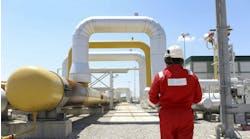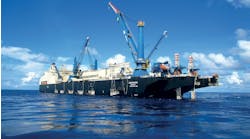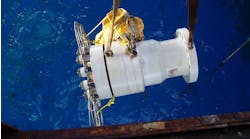Earth ground, full insulation systems in testing
Ronald M. Bass
Equilon Enterprises LLCCarl G. Langner
Shell E&P Technology (retired)
- Basic direct electric heating concept. [5,635 bytes]
- Field joint coating process [5,601 bytes]
- Earthed current direct electric heating system. [4,454 bytes]
Conventional remediation techniques, requiring pressure blowdown and injection of methanol at the well, are uncertain and may take months to melt the plug. If electric heating can be made to work, it is a very attractive alternative for both prevention and remediation of hydrate plugs having potentially high reliability and little adverse operational impact.
Electric heating may also prove effective in preventing or remediating paraffin plugging. In this case it may be possible to reduce capital costs by replacing conventional pigging loops with single heated flowlines.
A DeepStar Joint Industry Program is under way to develop and demonstrate direct electrical heating of externally insulated offshore pipelines and flowlines with the purpose of preventing or removing hydrate plugs or wax deposits. Two systems are being studied and tested:
- Complete electrical insulation of the flowline from the seawater
- Electrical communication with the seawater through anodes or other means.
Completely insulated system
The most straightforward way to heat a flowline is to pass current through the flowline itself, using the pipe as an electrical heating element. An electromagnetic phenomenon known as the skin effect confines the flow of current to a thin layer of steel near the outer surface of the pipe.Thermal insulation is required to prevent loss of heat from the flowline. Electrical insulation is required to confine the current to the pipe. For efficient electric heating, the flowline is coated with material that serves as both electrical and thermal insulation. The heated part of the flowline must be isolated electrically from adjacent piping as well as from the seawater in order to prevent current from short-circuiting through other parts of the system or possibly causing AC corrosion on unprotected piping.
At each end, electrical isolation is provided by a special purpose insulating joint. These insulating joints are of similar design to those used to isolate flowlines from attached offshore structures in order to conserve the sacrificial anodes, but with much higher voltage and current ratings and increased internal pressure capabilities. A power cable connects the insulating joint at each end with the power source on the host platform. As currently configured, insulating joints are sensitive to short circuiting due to water slugs or continuous water phase in the produced fluids during electrical heating. Placing each insulating joint at a high point in the flowline, such as at the top of a riser, partially relieves this concern, since water migrates downward during shut-in conditions.
The preferred flowline external insulation system is a multilayered polypropylene coating developed by Thermotite of Orkanger, Norway. The multiple layers in the coating result in a very low probability of electrical failure across the insulation. The primary risk of electrical failure is at the field joints. Consequently, testing of field joint integrity is a major component of the DeepStar program. Typical application of a molded field joint coating onto a Thermotite external insulation. Because the flowline is completely insulated, there is no need for cathodic protection, e.g., through anodic pipe coatings.
Depending on the flowline voltage, even a small defect in the coating that allows current to flow between the pipe and the seawater could result in a high AC current density at the pipe surface. Lab tests show that such leakage current could produce AC corrosion sufficient to severely damage the pipe in a short time. Consequently, it is necessary to assure that the external coating system is free of electrical defects. This is best accomplished by maintaining high quality control of the field jointing process since it will be very difficult to detect small defects.
A major focus of the DeepStar program is to evaluate how consistently field joints can be made without defects, and to determine how robust the field joints are under typical stress conditions during laying and operation. A series of field joints will be subjected to repeated bending at pipe strains comparable to worst case conditions expected in the field. After bending, the field joints will be subjected to electrical breakdown tests at 50,000 volts or higher.
Preliminary combined bending and electrical breakdown tests have been encouraging. A 40-ft length of 10-in. pipe coated with 2-in. thick multilayered Thermotite insulation and four simulated field joints spaced about 8 ft apart, survived more than 30 bending cycles with pipe strains up to 0.0065 and coating strains up to 0.0090. During these cyclic bend tests there were no signs of electrical breakdown at any of the field joints with 50,000 volts applied across the field joint coatings and adjacent insulation.
Electric heating field tests will be conducted on a complete flowline system, consisting of a 1/4-mile long section of 6-in. pipe coated with 2-in. thick Thermotite insulation and about 30 field joints, to verify the predicted electrical and thermal performance. This system, equipped with one insulating joint, will be operated at high current and low voltage for a short time to evaluate thermal performance, and then will be run open circuited at high voltage for several months to demonstrate electrical integrity. It is possible to return the current to the host platform through the sea water instead of through a cable, which results in a relatively inexpensive system. This seawater return will also be demonstrated as part of these tests.
These field tests, sponsored by the DeepStar Joint Industry Program, will be conducted by Alcatel Kabel Norge with the test pipe installed in the fjord adjacent to their plant in Halden, Norway.
Earthed current system
The completely insulated system described above, requires strict electrical integrity of the external coating, field joints, insulating joints, and subsea connections. The insulating coating and field joint system developed by Thermotite, together with the insulating joints manufactured by HydroTech Systems of Houston, Texas, offer a reasonable possibility of providing the necessary electrical integrity. In fact, Thermotite claim to have produced more than 6,000 consecutive field joints without a single defect.Prior to the Thermotite system, concern about the ability to produce reliable field joints led to the development of an alternative design which does not require electrical integrity of the coating or field joints. This development was undertaken by Sintef under sponsorship by Statoil, using a concept originally developed by Saga. This method is called the earthed current system because it intentionally allows current to flow in the water as well as in the pipe.
This concept originated from a similar approach used in electric railways. The same external insulation system described for the completely insulated flowline is used for this system, but here it is required only for thermal insulation.
Near the point where the power cable is attached to the pipe at each end, a series of electrodes is attached to the pipe over the insulation to allow current to flow into the water and thence parallel to the pipeline. The series of electrodes, which look much like conventional cathodic protection anodes, extends over a length of about 60 m spanning the connection point and allows current to flow out into the seawater over this 60-m transition zone.
The seawater current causes the voltage in the water to be virtually the same as the voltage in the adjacent pipeline. Consequently, if there is a defect in the insulation, there is no potential difference to drive current flow that could result in electrical failure or AC corrosion. The electrodes have enough total surface area to reduce current densities to a level that avoids AC corrosion of the electrodes.
Additional protection from both AC and DC corrosion is provided by conventional anode bracelets spaced along the pipeline, starting at a sufficient distance from the ends so that the voltage differences with the water are low and almost no AC current flows through the anodes.
Because the current in the seawater is concentrated near the pipe, parallel pipelines more than 10 meters away are not affected. However, power connections must be made at least 60 m from attached structures, such as production platforms or subsea wells, to avoid significant AC current flow into the structures.
The earthed current system has been tested by Sintef using a 208-m long test pipe in shallow water in Norway. A theoretical electrical model was also developed and validated by the field test. Somewhat surprisingly, power requirements are only modestly higher for the earthed current system than for the completely insulated system with the same amount of thermal insulation.
The DeepStar test apparatus described earlier will be configured to allow a test of the earthed current system as well as the completely insulated system, which should provide further validation of the Sintef model on this longer test pipe.
Other heating methods
Pipe-in-pipe flowlines have been used several times in the Gulf of Mexico and elsewhere because of their superior thermal performance. If a pipe-in-pipe system is connected as a short circuited coaxial line with an insulating joint welded into the flowline and casing at the platform end, this system can also be used for electric heating. An electrically heated pipe-in-pipe is by far the most thermally efficient and requires the lowest power of any direct heating method.However, this system also has several disadvantages.
- Electric heating excludes use of metal bulkheads, which frequently are welded across a pipe-in-pipe annulus to limit water intrusion in event of a leak in the outer pipe.
- Pipe-in-pipe systems are costly and difficult to lay in deepwater, and add considerable weight load to the host platform.
- Any contamination of the annulus with water or debris during construction could result in an unrepairable electrical failure.
Conclusions
Direct electric heating of pipelines and flowlines is a feasible and potentially cost effective means of providing flow assurance for deepwater pipelines and flowlines. Three different configurations of direct electric heating are possible: the pipe-in-pipe system, the completely insulated system, and the earthed ground system.- The pipe-in-pipe electric heating system is the most thermally and electrically efficient, but has a number of disadvantages including the highest risk of electrical breakdown.
- The completely insulated electric heating system provides intermediate thermal and electrical efficiencies, but requires all components including the external insulating coating to be holiday free.
- The seawater return option, in which the power cable is eliminated, is the least expensive heated flowline system.
- The earthed ground system, in which the flowline deliberately contacts the seawater, has the lowest thermal and electrical efficiency, but also has the lowest risk of electrical breakdown.
References
Finn Aarseth, "Use of Electrical Power in Control of Wax and Hydrates," OTC 8541, Proceedings of the Offshore Technology Conference, Houston, May 1997.Editor's Note: This is a shortened version of a paper presented at the Deep Offshore Technology Conference (DOT '98), held in New Orleans in November, 1998.Fred S. Epstein, Gary L. White, "Understanding Impedance Heating," Chemical Engineering magazine, May 1996.
Introduction to Direct Heating of Subsea Pipelines, brochure describing results of a joint project sponsored by Statoil, Saga Petroleum, CSO Norge, Alcatel Kabel Norge, and EFI, February 1998.
Copyright 1999 Oil & Gas Journal. All Rights Reserved.


